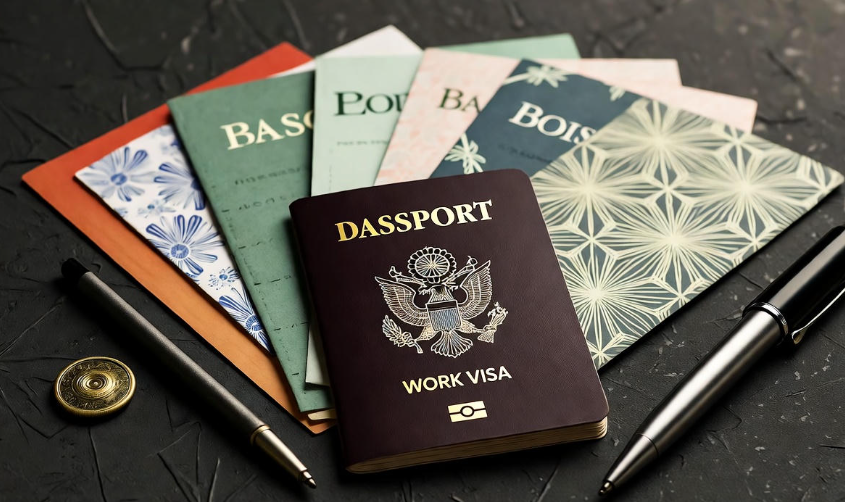So, you’ve finished your studies abroad and now you’re thinking… “Can I stay here and work?”
That’s a super common question — and a smart one! Many international students want to switch from a student visa to a work visa once they complete their studies, but the process can be confusing. Let’s break everything down into simple, clear steps that anyone can follow.
No heavy jargon. No complicated legal talk. Just plain, useful information.
Understanding What a Student Visa Actually Means
Before talking about how to convert your student visa into a work visa, you need to understand what your current visa allows.
A student visa is a temporary visa that lets you live in another country for the main purpose of studying. It usually has certain limits — like how many hours you can work, and for how long you can stay after graduation.
For example:
| Country | Typical Student Work Limit | Stay Duration After Studies |
|---|---|---|
| USA | Up to 20 hours/week (on-campus) | 60 days (F1 Visa) |
| UK | 20 hours/week during term | 2 years (Graduate Route) |
| Canada | 20 hours/week (off-campus allowed) | Up to 3 years (Post-Graduation Work Permit) |
| Australia | 48 hours/fortnight | Up to 4 years (Post-Study Work Stream) |
| Germany | 120 full or 240 half days/year | 18 months (to find a job) |
So, while you’re still on a student visa, you can work part-time. But once your studies are over, you’ll need to change your visa status if you plan to stay and work full-time.
Why Convert a Student Visa to a Work Visa?
This is probably obvious, but let’s state it anyway:
When you’ve studied abroad, you’ve already invested money, time, and effort. It makes sense to stay and build a career — especially since employers in that country value local graduates.
Some other reasons include:
✅ Better job opportunities and income
✅ Gaining international work experience
✅ Chance to apply for permanent residency later
✅ Professional networking and exposure
In short — it’s your stepping stone toward a long-term future abroad .
Basic Rule Before You Apply
Here’s the golden rule:
You must already have a valid student visa when applying for a work visa or post-study permit.
If your visa expires before you apply, things can get tricky. So, it’s smart to start your application a few months before your graduation or current visa expiry date.
Different Ways to Convert a Student Visa into a Work Visa
Now, this part depends on which country you’re in. Each country has its own immigration laws, but most of them fall into one of the following categories
1. Post-Graduation Work Permit (PGWP) or Post-Study Work Visa
This is the most common route. Many countries offer an automatic “work extension” after studies.
-
Canada offers the Post-Graduation Work Permit (PGWP) which lets you stay and work for up to 3 years (depending on your study duration).
-
Australia has the Temporary Graduate Visa (subclass 485) for 2 to 4 years.
-
UK allows 2 years of full-time work under the Graduate Route, and 3 years for PhD graduates.
These are usually open work permits — meaning you can work for any employer and even switch jobs.
Tip: Make sure your university or course is recognized by the country’s immigration office, or your post-study visa may be denied.
2. Employer-Sponsored Work Visa
If you already have a job offer from a company, you can convert your student visa into an employer-sponsored visa.
For example:
-
In the USA, you can move from an F-1 visa to an H-1B visa through employer sponsorship.
-
In the UK, you can switch from a student visa to a Skilled Worker Visa.
-
In Australia, employers can nominate you for the Temporary Skill Shortage (subclass 482) visa.
This usually requires your employer to prove that no local candidate could fill the position — but if your skill is in demand, this is one of the strongest routes to stay.
3. Temporary Graduate or Trainee Visa
Some countries have special short-term visas for fresh graduates to get work experience.
Example:
-
Germany allows graduates to stay for 18 months to look for a job.
-
Japan offers “Designated Activities” visas for students to work after graduation.
-
New Zealand has a “Post-Study Work Visa” that lets you stay 1–3 years.
These are great if you’re just starting out and still exploring job options.
4. Apply for an Internship or Practical Training
If your student visa includes an internship option or practical training extension, use it!
In the USA, for instance, the OPT (Optional Practical Training) and CPT (Curricular Practical Training) programs let international students work in their study field before switching to an H-1B visa.
This helps you gain experience and find an employer who may later sponsor your work visa.
5. Permanent Residency Pathways
Some students directly move toward permanent residency instead of applying for a work visa first — especially in countries like Canada and Australia.
Example:
-
Canada’s Express Entry (Canadian Experience Class) favors international graduates with local work experience.
-
Australia’s PR pathways include options for international students who study in regional areas.
If you’re planning to settle long-term, this could be a smarter and more direct route.
Documents You’ll Usually Need for the Conversion
Each country has its checklist, but here’s a general list of what’s usually required:
Required Documents:
-
Valid passport
-
Current student visa
-
Proof of course completion (transcripts or degree)
-
Job offer letter (if applicable)
-
Proof of financial means (bank statements)
-
Health insurance documents
-
Updated resume/CV
-
Police clearance certificate
-
Application form for new visa type
-
Medical report (sometimes)
Make sure all your documents are translated into English (if they aren’t already) and verified.
Step-by-Step Process to Convert Your Visa
Now, let’s get practical. Here’s what the actual process looks like:
-
Complete your studies successfully (no pending courses).
-
Check your visa conditions — how long you can stay after course completion.
-
Find a job or internship offer in your field.
-
Gather required documents and scan them properly.
-
Apply for a new visa online through your country’s immigration portal.
-
Pay the required fees (these vary from $200–$800 on average).
-
Wait for approval — processing can take anywhere from a few weeks to a few months.
-
Once approved, update your visa status and get your new work permit.
Common Mistakes Students Make (and How to Avoid Them)
Many students lose their legal status because of small mistakes. Don’t let that be you!
Here are a few common ones:
❌ Waiting too long after your student visa expires
❌ Working full-time before getting a work visa
❌ Submitting incomplete or fake documents
❌ Not informing the immigration office about job changes
❌ Ignoring health insurance or tax obligations
Always keep your paperwork clean, stay within your visa limits, and double-check deadlines.

Comparison of Student vs Work Visa
| Feature | Student Visa | Work Visa |
|---|---|---|
| Purpose | Study | Employment |
| Duration | Course duration + short stay | 1–5 years (depends on type) |
| Work Rights | Limited hours | Full-time |
| Sponsor | Educational institution | Employer or self |
| Renewal | After enrollment extension | Job or employer renewal |
| Path to PR | Indirect | Direct (in many countries) |
Which Countries Make It Easy to Convert a Student Visa to a Work Visa?
Here’s a quick breakdown:
Canada – One of the easiest, thanks to PGWP and PR pathways.
Australia – Smooth process under subclass 485 visa.
UK – The new Graduate Route makes it simple and open.
Germany – Generous 18-month job search period after graduation.
New Zealand – Straightforward post-study visa for up to 3 years.
The USA is stricter, but if you manage OPT or an H-1B sponsorship, it’s still possible.
Tips to Increase Your Chances of Approval
✨ Stay in the same study-to-job field (e.g., IT student → IT job)
✨ Apply before your student visa expires
✨ Keep your grades decent (some visas require good academic standing)
✨ Find a reputable employer for sponsorship
✨ Keep all receipts and immigration correspondence safely
Also — always check your country’s official immigration website before submitting your application. Rules can change every year.
Real-Life Example (Canada)
Let’s say you studied Computer Science in Canada.
-
You graduate from a 2-year program at a public college.
-
You apply for a PGWP, which lets you work for 3 years.
-
You find a job as a Software Developer within that period.
-
After 1 year of Canadian experience, you apply for Express Entry (PR).
That’s how many students make their study visa turn into a permanent opportunity .
Cost of Conversion
Visa fees vary widely:
| Country | Visa Conversion/Work Visa Cost | Processing Time |
|---|---|---|
| USA | $460 – $500 | 2–6 months |
| UK | £700 – £1,500 | 3–8 weeks |
| Canada | CAD 255 | 4–12 weeks |
| Australia | AUD 1,730 | 2–3 months |
| Germany | €100 – €140 | 1–2 months |
Make sure to add extra budget for document translations, medical exams, and insurance.
What Happens If Your Application Is Rejected?
Don’t panic .
If your work visa application is rejected, you can:
-
Appeal or reapply with corrected information
-
Apply for another type of visa (internship, graduate trainee, etc.)
-
Return to your home country and apply again from there
Always check the reason for refusal — sometimes it’s just a missing document or wrong category selection.
A Friendly Reminder
Always, always follow legal routes. Never overstay your student visa or work illegally. Even one violation can make it impossible to get a future visa or PR.
Think of this process like a staircase — each step matters.
FAQs About Converting Student Visa to Work Visa
Q1: Can I convert my student visa to a work visa without a job offer?
In most countries, no. You’ll need either a post-study permit or a valid job offer to apply for a full work visa.
Q2: How soon can I apply for a work visa after graduation?
Usually right after your final results or within the “grace period” (30–180 days, depending on country).
Q3: Can I work while my work visa is processing?
Only if your current visa allows it. Otherwise, you must wait for approval.
Q4: Do grades matter for work visa approval?
Not directly, but good academic records help you get better job offers, which improves your visa chances.
Q5: What if my visa expires while waiting for approval?
You may need to apply for a “bridging visa” (available in countries like Australia and Canada) to stay legally until a decision is made.
Q6: Can I bring my spouse or family with me after conversion?
Yes, most work visas allow dependent applications once you’re legally employed.
Final Thoughts
Converting a student visa into a work visa is one of the smartest career moves if you want to grow internationally. It’s not just about staying abroad — it’s about building a strong future, gaining experience, and making your education truly worth it.
So don’t rush, plan early, talk to your university’s international office, and make sure your paperwork is in order.
Once you land your dream job abroad, you’ll realize every document and every form was totally worth it!




